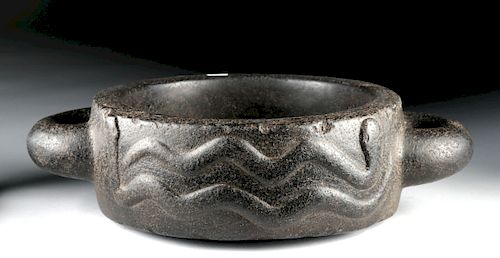Inca Basalt Handled Vessel with Serpents
Lot 123
About Seller
Artemis Gallery
686 S Taylor Ave, Ste 106
Louisville, CO 80027
United States
Selling antiquities, ancient and ethnographic art online since 1993, Artemis Gallery specializes in Classical Antiquities (Egyptian, Greek, Roman, Near Eastern), Asian, Pre-Columbian, African / Tribal / Oceanographic art. Our extensive inventory includes pottery, stone, metal, wood, glass and textil...Read more
Estimate:
$10,000 - $15,000
Absentee vs Live bid
Two ways to bid:
- Leave a max absentee bid and the platform will bid on your behalf up to your maximum bid during the live auction.
- Bid live during the auction and your bids will be submitted real-time to the auctioneer.
Bid Increments
| Price | Bid Increment |
|---|---|
| $0 | $25 |
| $300 | $50 |
| $1,000 | $100 |
| $2,000 | $250 |
| $5,000 | $500 |
| $10,000 | $1,000 |
| $20,000 | $2,500 |
| $50,000 | $5,000 |
| $100,000 | $10,000 |
| $200,000 | $20,000 |
About Auction
By Artemis Gallery
May 23, 2019
Set Reminder
2019-05-23 10:00:00
2019-05-23 10:00:00
America/New_York
Bidsquare
Bidsquare : Exceptional Day 2 Ethnographic Tribal Fossils
https://www.bidsquare.com/auctions/artemis-gallery/exceptional-day-2-ethnographic-tribal-fossils-4136
Day 2 of an important 2-day auction featuring exceptional ethnographic art from around the world. Today's sale will feature Pre-Columbian from the ancient americas, Native American, African / Tribal, Oceanic, Spanish Colonial, and incredible Fossils. Artemis Gallery info@artemisgallery.com
Day 2 of an important 2-day auction featuring exceptional ethnographic art from around the world. Today's sale will feature Pre-Columbian from the ancient americas, Native American, African / Tribal, Oceanic, Spanish Colonial, and incredible Fossils. Artemis Gallery info@artemisgallery.com
- Lot Description
Pre-Columbian, North Coast Peru Inca, ca. 1400 to 1533 CE. A skillfully carved black volcanic basalt vessel, the body of a broad cylindrical form with integral twin loop handles and two snakes depicted in relief on each side. The serpents slither in sinuous formations, one above the other, their heads facing in opposite directions. In the Pre-Columbian world, animals were highly symbolic beings. Serpents were metaphors for rain and blood, two life-giving fluids. At the same time, they were viewed as creatures that portend great danger. Their ability to shed their skin each year, and thus rejuvenate themselves, also made them symbolic of health and renewal. A striking vessel replete with strong technique, attractive form, and layers of symbolic meaning. Size: 15.25" W handlespan x 4.25" H (38.7 cm x 10.8 cm)
In their discussion of another Inca basalt vessel with snake motifs in the British Museum, Smarthistory scholars have suggested that it was probably kept in the Coricancha (Temple of the Sun) or nearby sacred buildings - most likely used to hold offerings or simply water as a means of seeing into the underworld via its reflective surface. The coiled - or in this case sinous - serpent bodies were most likely intended to resemble flowing water. (https://smarthistory.org/inka-an-introduction/) - The British Museum, "Inka stone vessels," in Smarthistory, March 1, 2017, accessed May 6, 2019, https://smarthistory.org/inka-an-introduction/.
Provenance: private southwestern Pennsylvania, USA collection
All items legal to buy/sell under U.S. Statute covering cultural patrimony Code 2600, CHAPTER 14, and are guaranteed to be as described or your money back.
A Certificate of Authenticity will accompany all winning bids.
We ship worldwide and handle all shipping in-house for your convenience.
#146298Normal surface wear commensurate with age. Old chips to rim, base, and high-pointed areas. Otherwise intact. Serpent forms are vivid. Label indicating "basalt" on bottom.Condition
- Shipping Info
-
All shipping is handled in-house for your convenience. Your invoice from Artemis Gallery will include shipping calculation instructions. If in doubt, please inquire BEFORE bidding for estimated shipping costs for individual items.
-
- Buyer's Premium



 EUR
EUR CAD
CAD AUD
AUD GBP
GBP MXN
MXN HKD
HKD CNY
CNY MYR
MYR SEK
SEK SGD
SGD CHF
CHF THB
THB
















